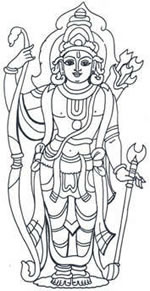The Ten Avataras 7
A Psychological Study of the Evolution of Humankind
Swami Satyadharma Saraswati
7. RAMACHANDRA AVATARA
 Parashurama,
the sixth incarnation, strengthened the brahmin caste by annihilating
the kshatriyas. Ramachandra was born to restore the kshatriya glory and
honour by exemplifying the ideal man, who is dedicated to the protection
of dharma and righteousness. Parashurama was born of the priestly class
whose dharma was not to fight but to promote spiritual ideals. However,
he used his spiritual power on the battlefield, venting his anger, instead
of in meditation. Therefore, his glory was diminished in the end, whereas
Ramachandra was born a kshatriya, whose duty was to fight and subdue the
evil elements. However, Rama was never obsessed with anger or violence
as was Parashurama. He fought because he had taken a vow to give protection
to those who sought it from him, and he never swerved from this vow.
Parashurama,
the sixth incarnation, strengthened the brahmin caste by annihilating
the kshatriyas. Ramachandra was born to restore the kshatriya glory and
honour by exemplifying the ideal man, who is dedicated to the protection
of dharma and righteousness. Parashurama was born of the priestly class
whose dharma was not to fight but to promote spiritual ideals. However,
he used his spiritual power on the battlefield, venting his anger, instead
of in meditation. Therefore, his glory was diminished in the end, whereas
Ramachandra was born a kshatriya, whose duty was to fight and subdue the
evil elements. However, Rama was never obsessed with anger or violence
as was Parashurama. He fought because he had taken a vow to give protection
to those who sought it from him, and he never swerved from this vow.
Another vow he had taken was to be totally responsible to the people, rather than to anything that was his personally. Throughout his life he always considered the welfare of others before his own. These were the policies of his life which he always observed whatever the circumstance. Rama followed the line of dharma and duty right from childhood, so he always remained unperturbed. Even in adverse circumstances his mind did not waver. His behaviour was excellent in every situation, and is still exemplified today. He never misused his powers or exhibited his divinity. He always behaved as a human being should.
Rama was never tempted or provoked by circumstances. Being impervious to praise or blame, he was never flattered or insulted. Thus his personality stands out even today as ideal, unique and most glorious. He represents the ideal of uncompromising goodness. Rama was at once the perfect son, true husband, devoted brother, real friend, noble enemy and model king. Rama is always depicted carrying a bow and arrows, symbolising his preparedness to face every challenge, and his strength which was used to maintain peace and justice, within and without. Rama represented the ideal of aggressive goodness, as opposed to passive goodness. He would not passively accept anything that was inconsistent or contrary to dharma. Thus he stood for righteousness and destroyed the unrighteous.
The advent of Rama represents a period of conflict followed by balance between the higher mind and the lower mind. At this stage of development, man is no longer under the total dominion of the lower mind, but is now influenced by the dual aspect of mind. The earth is no longer a mere material thing, but has a higher intelligence presiding over it. India and Lanka represent two continents or levels of conscious development; one is inhabited by the Aryans of higher mind and the other by the non-Aryan rakshasas of lower mind.
The human mind develops in four areas: buddhi, chitta, manas and ahamkara. So the four brothers were born: Rama, representing buddhi, with his three brothers, Bharata, Lakshman and Shatrughna representing chitta, manas and ahamkara. Rama was born of Dasharatha, who was a great emperor and direct descendent of the Ikshvaku or solar lineage. The word dasha here signifies the ten senses and ratha is the chariot. So Dasharatha was the one who could drive or control the chariot of the ten senses, whereas Ravana, whom Rama was born to destroy, is depicted with ten heads, symbolising that his mind was ruled by the ten senses.
So the advent of Rama indicates a period when the higher mind first grapples with the senses and the lower mind subdues them, and then begins to establish an order whereby harmony and balance can be maintained between the higher and lower dimensions of consciousness. Thus kama or desire is overcome. The influence of tamas and rajas in the world, represented by Ravana and the other rakshasa kings discussed in previous incarnations, is balanced by sattwa, represented by Rama.
Continued in the next issue